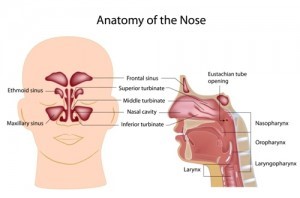Winter Sinus Pain: Do’s and Don’ts for Sinus Relief!
CONNECT WITH US:

[updated January 2020 – this post contains affiliate links]
It’s hard not to see a million television ads for sinus, cold, and flu relief on a daily basis. The winter seems to be a time when the nose takes the blows!
The reason is that the nasal tissue and sinuses play an important role in helping our respiratory system accommodate the brutally cold weather in most parts of the country. The dry air quality and the fact that we spend most of our days indoors doesn’t help either.
The most important thing you can do to protect yourself from sinus pain and other problems is maintaining good sinus hygiene and avoiding medications that can make the problem worse.
How Do Your Sinuses Work?

The sinuses (see anatomy chart) are a combination of intricate, delicate chambers that allow air to flow from the nose into the rest of the respiratory system. Interestingly, the function of the sinuses is not exactly known, but it is thought to be important in phonation (how your voice sounds). This is why many of my opera singers and Broadway actors are so vigilant in following my instructions to keep their sinuses clean and infection-free.
To understand why sinuses become infected, you need to understand some basic, logical anatomy. The sinuses are analogous to narrow, tortuous roads–so it is important that those “roads” don’t become congested and blocked up. Sinus congestion can occur from changes in the atmospheric pressure (nothing you can do about that), from allergens and finally from the mucus from infections themselves.
My Plan for Sinus Relief | What to Do
My immediate plan when a patient begins to feel sinus congestion or pressure is to use a topical decongestant, such as Afrin, along with a nasal steroid. Both are now over-the-counter.
I know many patients are afraid or worried about using Afrin, but it is a very effective nasal medication if used appropriately. The key is not to become an “Afrin Junkie”. My patients are carefully instructed to use Afrin nasal mist for 3 days and always followed within 5 minutes by the Nasal cortisone spray. By implementing this combination, you avoid the rebound effect from Afrin and won’t become dependent.
After 3 days, most patients feel significant sinus relief and have avoided developing a sinus infection. Then, I usually have the patient use the Nasal cortisone spray for another week or two just to make sure the sinuses stay open. If a patient is still not feeling enough relief from sinus pain, I will prescribe an oral decongestant like Sudafed for a few days, along with a pain reliever (Tylenol or Advil sinus both can be used). I do warn patients not to use the decongestant pills at night because they can keep you awake, and also not to use these medications without supervision if you have high blood pressure or a heart condition.
What NOT to Do

Don’t jump to take an antibiotic right away if you feel sinus pain. Research clearly shows most congestion and even infections are not due to bacteria, but viruses. I too often see patients take too many antibiotics. They don’t get better, they get side-effects from the antibiotics. There is a place for antibiotics in sinus infections but in select cases.
Also, don’t take an antihistamine, even if it’s with a decongestant: examples such as Allegra-D or Zyrtec-D. Why? Antihistamine doesn’t help relieve congestion, and they are very drying and this makes it harder to allow the mucus to drain out from the nose.
Also, Netti pots have been recommended by Dr. Oz and others which I believe are fine for sinus hygiene maintenance. However I’m not sure there is any real benefit in an acute situation, and it may be more irritating in some cases!
In my book, Dr. Dean Mitchell’s Allergy and Asthma Solution: The Ultimate Program for Reversing Your Symptoms One Drop at a Time, I devote a whole chapter to the latest research on managing chronic sinus pain.
Oh, and if you are in a bind, say, on the road and not able to get to a pharmacy, a good old hot bshower with steam can bring a temporary smile to your sinuses!
– Dr. Dean Mitchell M.D.
Mitchell Medical Group in NYC and Long Island

About the Author – Dr. Dean Mitchell, M.D.
Dr. Dean Mitchell, M.D. is a Board Certified Allergist and Immunologist based out of NYC. He graduated from the Sackler School of Medicine and completed training at the Robert Cooke Allergy Institute in New York City. He is also a Clinical Assistant Professor at Touro College of Osteopathic Medicine, a fellow of the American Academy of Allergy, Asthma, and Immunology, and the author of Dr. Dean Mitchell’s Allergy and Asthma Solution: The Ultimate Program for Reversing Your Symptoms One Drop at a Time.  Dr. Dean Mitchell, M.D. has also been featured in The New York Times, The Huffington Post, Fitness Magazine, Dr. Oz and News NY 1. Dr. Mitchell also hosts the podcast The Smartest Doctor in the Room – a combination of a lively, personal, and in-depth interview with top healthcare specialists.
Dr. Dean Mitchell, M.D. has also been featured in The New York Times, The Huffington Post, Fitness Magazine, Dr. Oz and News NY 1. Dr. Mitchell also hosts the podcast The Smartest Doctor in the Room – a combination of a lively, personal, and in-depth interview with top healthcare specialists.



